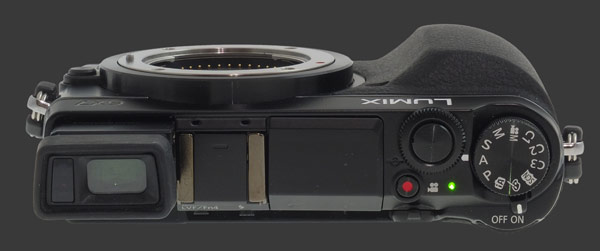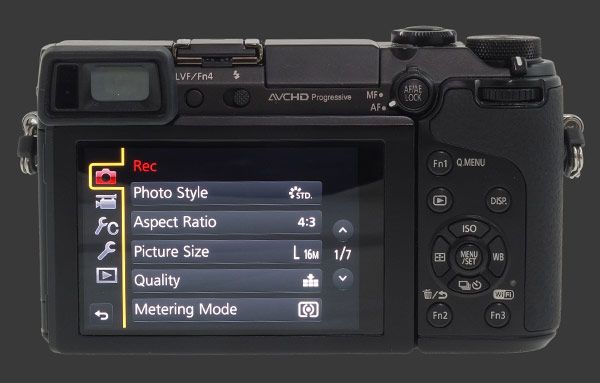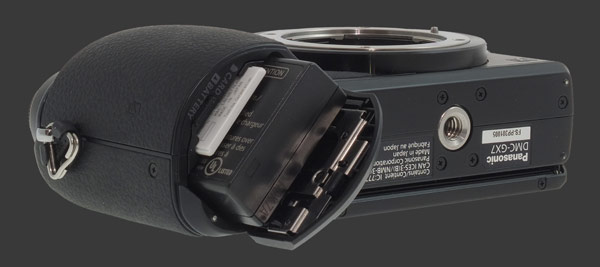The Panasonic Lumix DMC-GX7 has a boxy shape with a short rubber grip and protruding EVF. The grip has a broad curve which relatively comfortable for such a compact camera. Rubber wraps from the grip to the back of the camera to provide traction. There are strap eyelets on either side with the grip-side one in a poor position that constantly digs into the index-finger.
The top plate of the GX7 is not so busy with a few controls packed together above the grip and a hot-shoe near a stereo microphone. The EVF occupies the extreme-left which makes it perfectly comfortable and it can be tilted 90° upwards.

On the right-side, there is a dedicated video-record button just behind a two-stage shutter-release surrounded by the main control-dial. A traditional mode-dial is to the right of the shutter-release. Just below the mode-dial, there is a simple power-switch with a strong detent, making accidentally powering on the GX7 impossible.
The Video Record button is flush with the surface of the camera. It starts recording video almost instantly yet stops such as the last second or so gets chopped. The exact delay depends on the video mode but is roughly ½s for 1080p. This occurs whether the camera is in Video mode or not. Luckily, at least there is a Video mode which lets one accurately prepare framing for video.
The shutter-release has a moderate amount of travel with a soft halfway point to minimize shaking the camera when taking a shot. The control-dial around is easy to reach and has good detents, just like the textured mode-dial. There are 11 positions on the mode-dial:
- All the traditional PASM modes get their own position. P offers Program-Shift.
- Video mode allows recording of video in any PASM mode, as selected in the video menu.
- Three custom modes. C1 and C2 store a single set of parameters while C3 offers 3 memories for parameters.
- Intelligent Auto mode offers automatic operation while letting users specify EC and WB directly.
- The Scene position groups all 24 modes.
- The Effect position groups all 8 effects.
The back of the GX7 is dominated by a 3″ touchscreen LCD with 1 megapixel. It is mounted on an impressively sturdy tilting hinge which can be angled downwards 45° for overhead shots or up to 85° upwards. Luckily, the touchscreen feature can be disabled to avoid accidental actions.

Visibility of the display is very good, so is the anti-reflective coating. The viewing angle is quite impressive. The display refreshes quickly and follows motion well. This camera is sadly not Exposure-Priority, so exposure is not always previewed correctly. There is a optional misleading live-histogram based on the brightness of the display rather than that of the metered exposure.
A high number of controls cover the remainder of back. Just beside the EVF is a customizable button. By default it toggles the EVF but, since this is done automatically by the essential Eye-Start sensor, it can be assigned to a useful function. Right next to it is a mechanical spring-loaded flash-release button.
At the upper right corner of the LCD is the combined AE-L/AF-L button, surrounded by the AF/MF switch. Each of these work exactly as expected. Further right is the camera’s second control-dial. This dial is clickable which toggles controls of EC. This modal interface is not ideal since it is both accident-prone and time-consuming.
There are buttons arranged as a 4-way controller, including central Menu button, plus no fewer than 5 extra buttons. The top one and two lower ones are customizable. By default, Fn1 invokes an icon Quick Menu to change common settings. In an impressive amount of customization, the menu itself is user-configurable.
Still above the 4-way controller, the Playback and Disp button work as usual. The former toggles between Capture and Playback mode, while the former cycles through various display modes. Each direction of the controller is assigned a function:
- Up: Selects ISO. There are options from 200 to 25600, plus a low 125 when ISO Expansion is enabled. Two Auto ISO modes work slightly differently: One selects sensitivity depending on shutter-speed only, the other also uses subject motion.
- Right: Selects White-Balance. The screen which appears when Right is pressed is also used to fine-tune white-balance or enable WB bracketing.
- Down: Selects a drive mode: Off, Single-Shot, ContinuousSuper-High Speed (40 or 10 FPS @ 4MP) , High-Speed (5 FPS) without preview, Medium Speed (4 FPS) or Low speed (2 FPS), Bracketing and Self-Timer2s, 10s or 3-frames at 10s. There is no difference between Off and Single-Shot as far as we can tell.
- Left: Selects the AF mode: Pinpoint, Single-Point, Automatic 23-Area, Tracking and Face-Detect. The focus point or area, depending on the mode, can be set by pressing Down fro there. Pinpoint allows the selection of an exact point while Single-Point allows the selection of an image-area. Four area-sizes are available.
The Panasonic Lumix DMC-GX7 feels light yet sturdy. The body is made of rigid plastic with metal top and bottom plates. The battery-compartment door has a little flex in the hinge but everything is well built. At the bottom there is a metal tripod mount directly inline with the optical center of the camera. This is ideal for panoramic photography.

Ergonomics of the GX7 are good. There are dual control-dials and buttons for every important settings, plus an outstanding number of customizable buttons. The modal EC function which Panasonic insists of implementing is annoying at best. The eyelet on the grip side is a pain after prolonged shooting but should not be a problem for casual photography.
3

